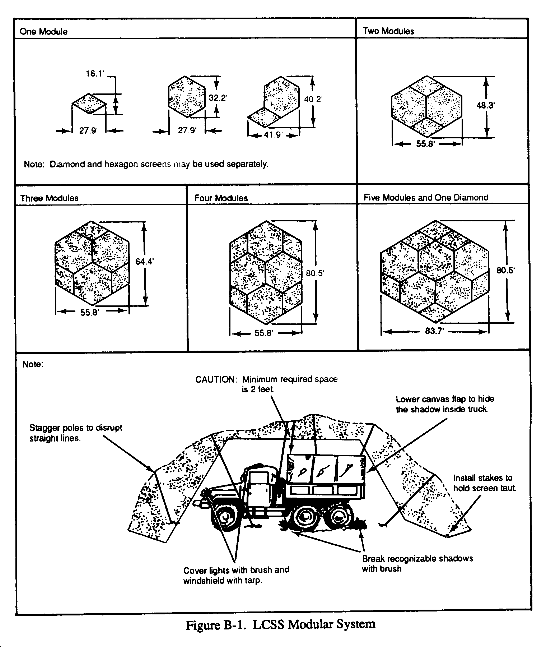


LCSS - Light-Weight Camouflage Screen System
Modern sensing devices detect objects or terrain disturbances even though they are well camouflaged. These devices detect reflected short-wave and radiated long-wave infrared (ir) energy. Special video devices "read" ir energy and detect dead or dying vegetation as well as objects painted similar to their surroundings. In the past, when manned attack aircraft flew high and slow, aircrews had an optimum perspective and a relatively long time to visually recognize and acquire targets. Effective camouflage, concealment, and deception (CCD) then demanded elaborate visual deceptions and comprehensive coverage designed to make the target nearly invisible. Today, attacks are typically executed at low altitudes and high speeds and target recognition and acquisition relies heavily on visual, thermal infrared, and radar imagery.
Effective CCD now typically demands less elaborate deceptions.
The Light-Weight Camouflage Screen System [LCSS] is a camouflage net that provides protection in areas where there is no large convenient overhead cover, such as unplowed fields, rocky areas, grasslands, and other wide-open spaces. The LCSS is a modular system consisting of a hexagon screen, a diamond-shaped screen, a support system, and a repair kit. Any number of screens can be joined together to cover a designated object or area.
LCSSs provide excellent cover when properly used. They are radar scattering or radar transparent. The radar scattering screen contains minute fibers of stainless steel which inhibit the passage, reflection, and return of a threat radar signal. The radar transparent version is made without these fibers. The desert version of the LCSS provides concealment against visual, near infrared, and radar target acquisition/surveillance sensor devices. A radar transparent version of the LCSS allows US units to camouflage radar without degrading operations. The desert camouflage net is a complete cover since it depends on ground surface imitation, both in color and texture, for effect.
 The LCSS conceals in four different ways:
The LCSS conceals in four different ways:
- Casts patterned shadows that breakup the characteristic outlines of an object.
- Absorbs and scatters radar returns (except when radar-transparent LCSS is used).
- Dissipates infrared radiation.
- Simulates color and shadow patterns that are commonly found in a particular region.
LCSSs can usually be set up in 20 to 25 minutes. When erecting the LCSS, keep the net structure as small as possible. Maintain the netting at a minimum of two feet from the camouflaged objectís surface and avoid eye-catching steeples and shadows. Lines between support poles should be gently sloped so that the net blends into its background. The net should extend completely to the ground to prevent creating unnatural shadows that are easily detected. Doing this will ensure the LCSS effectively disrupts the objectís shape and actually absorbs and scatters radar energy. The net should extend all the way around the object to ensure complete protection from enemy sensors.
The LCSS will rarely be used without supplemental camouflage. The LCSS does not make an object invisible. Other camouflage techniques are necessary to achieve effective concealment. Troops must cover or remove all of the objectís reflective surfaces (such as mirrors, windshields, and lights) and ensure that they disrupt or disguise an objectís shadow when camouflaging.
Sources and Resources
http://www.fas.org/man/dod-101/sys/land/lccs.htm
Maintained by Robert Sherman
Originally created by John Pike
Updated Saturday, September 12, 1998 6:35:55 AM



